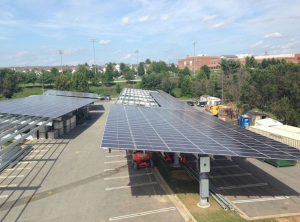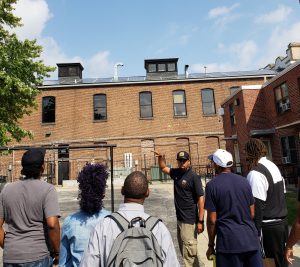Exploring Maryland Solar Energy Programs
By David Comis, Solar Energy Program Manager
The Maryland Energy Administration (MEA) has multiple funding and technical assistance opportunities for immediate deployment of commercial-scale solar projects. This article briefly discusses solar programs that should be of interest to cities, counties, and solar developers alike.
Public Facility Solar Grant Program
New in fiscal year 2021, MEA is now offering up to $2,500/kW for the purchase of solar on an eligible public facility, either as a solar canopy or rooftop array of 50kW or smaller. This incentive level should be sufficient to cover most of the costs of the solar project. The program defines a public facility as: “Any building owned or under long term lease (greater than 25 years) by a state, county or municipal agency or political subdivision thereof, including libraries, museums, schools, hospitals, auditoriums, sport arenas, university buildings, etc.” If the applying government entity would like to participate in a 3rd-party owned system, assistance is also available to the tune of $400/kW (capping at $200,000/project) for rooftop solar systems and $600/kW (capping at $300,000/project) for solar canopy systems over parking lots or parking garages. This is a powerful, competitive program and applications will be considered in two tranches, on the following deadlines: November 15, 2020 and February 17, 2021.
If a project is still in the formative stage and technical assistance is needed instead, funding is available under this program. Assistance can be in the form of a grant with which the government entity can procure their own technical assistance provider, or in the form of direct technical assistance from experts sourced by MEA (with no direct outlay by the requesting applicant). Technical assistance awards are expected to be $10,000 or less, but larger amounts may be granted with sufficient justification.
UPDATED – Resiliency Hub Grant
Although not the same as an emergency shelter, a resiliency hub can provide an immediate resource for residents during a large-scale service outage, and to a lesser extent, during the recovery from: (1) natural emergency events such as high heat, flooding, hurricanes, coastal storms, winter storms, earthquakes and high wind conditions, or (2) man-made disasters such as fires, explosions, or uprisings.
A resiliency hub is a venue where solar PV and battery energy storage are designed to provide electricity to meet important community needs during extended electric grid outages. Resiliency hubs are required to include: emergency heating and cooling; refrigeration of temperature-sensitive medications; plug power for charging of cell phones, durable medical equipment and computer batteries; ventilation and emergency lighting. A resiliency hub may also be identified as a designated location (by the city, county, or state) for the distribution of emergency services during extended grid outages.
Resiliency hubs are NOT replacements for emergency shelters and as such they are not: required to be designed to survive extreme weather; required to have food service capabilities; or to have showers and locker rooms. Resiliency hubs must meet basic requirements necessary for occupancy, including health and sanitation.
MEA is offering up to $3,000/kW of required solar for the installation of a resiliency hub in a low-and-moderate income neighborhood. This is considered Area of Interest 1. This grant should pay for about half of the cost of a solar plus battery system that can island from the grid, as well as new panels and rewiring that may be required. Grants are limited to $500,000. In essence these are nanogrids (microgrids for critical loads of a portion of a building) that can be used to support the needs of the surrounding neighborhood. The building owner gets the use and benefit of the solar plus battery storage system for the full year, less the time when the resiliency hub is in operation. As such, the building owner/operator will see energy savings and potentially a reduction in demand charges.
This program is open to state agencies, county and local governments, businesses, plus nonprofits. The venue options for resiliency hubs are open as they may be installed to fit the available opportunities.
For the first time, this year’s program will also consider resiliency hubs for community and public buildings. This is considered Area of Interest 2.
Applications for both Areas of Interest 1 and 2 must be received by MEA no later than close of business on March 1, 2021.
Solar Canopy Program
The Parking Lot Solar PV Canopy with EV Charger Grant, commonly called the Solar Canopy Grant, has been operating since 2014, with varying levels of incentive. This year MEA will provide $600 per kW of solar in a solar canopy, with a cap of $300,000. Unlike other programs, MEA does not provide a maximum size of the solar canopy, only the cap on the incentive.
This program is open to state and local governments, business and nonprofits. The system may be purchased by the site owner or installed as a 3rd-party-owned system. The minimum canopy size is 75 kW-dc. As the system must be net metered, the maximum effective system size is 2,000 kW-ac.
Solar canopies provide energy to a building or microgrid, provide shade to the vehicles that park underneath, and protection from rain, snow, and hail. In addition, the vehicle interiors are cooler than if parked in the sun, providing comfort in the summer, and minimizing air conditioning needed at start-up. Applications for this competitive grant are due December 8, 2020.
Community Solar LMI-PPA Grant
Community solar is a form of virtual net energy metering where the consumer gets energy credit on a local bill for energy produced off-site (but within the same electric utility service area). MEA’s Community Solar Low-to-Moderate Income Power Purchase Agreement (LMI-PPA) Grant is open to Community Solar Subscriber Organizations that develop and build a Community Solar array under the low-to-moderate income (LMI) category (low income is defined as at or below 175% of the federal poverty level and moderate income is defined as at or below 85% of median income by county), and Subscriber Organizations that develop and build a Community Solar array under the “Small/Brownfields/Other” category that ensures at least 51% of the array energy is subscribed to subscribers who initially qualify for the Low or Moderate income categories as discussed above. As the grant requires an electricity rate pricing structure commitment for 20 years, the incentive is based on a net present value calculation of the savings passed on to the LMI subscriber over the 20 year period. Grants are limited to $500,000 per project.
The program can be found here, with the incentive calculation found on the Excel worksheet under the “Application Process” dropdown.
In addition, the Climate Access Fund received a $3 million grant from MEA to run a Community Solar Guaranty Grant Program. This program guarantees the energy payments of LMI subscribers to the community solar developer for the first 7 years of the eligible LMI Community Solar Project, decreasing risk to the developer and thus encouraging LMI projects.
The Bottom Line
Each of these programs can help improve the economics of a project under consideration; but, more importantly, they may help you propose a project that can bring the benefits of solar to people in all sectors of society. Please consider developing a project under one of these programs. For further information, contact David Comis, Solar Program Manager at 443-908-1743 or, and/or Abigail Peryea, Deputy Solar Program Manager, at 410-371-6381.




 1-888-373-7888
1-888-373-7888 233733
233733